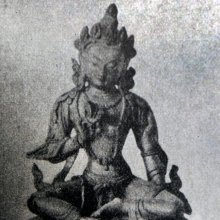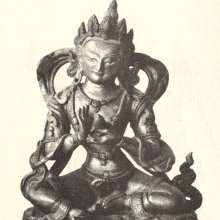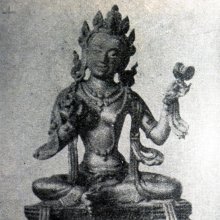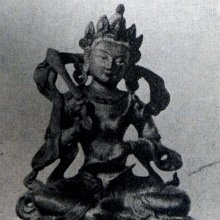Tula, Tūlā, Tūla, Tūla, Tulā, Tuḻa, Tuḻā: 34 definitions
Introduction:
Tula means something in Buddhism, Pali, Hinduism, Sanskrit, Jainism, Prakrit, the history of ancient India, Marathi, Hindi, biology, Tamil. If you want to know the exact meaning, history, etymology or English translation of this term then check out the descriptions on this page. Add your comment or reference to a book if you want to contribute to this summary article.
Alternative spellings of this word include Tool.
Images (photo gallery)
(+18 more images available)
In Hinduism
Ayurveda (science of life)
Kalpa (Formulas, Drug prescriptions and other Medicinal preparations)
Source: Shodhganga: Edition translation and critical study of yogasarasamgrahaTulā (तुला) refers to a unit of measurement of weight (1 tulā equals 4.8kg; 20 tulās = 1 bhāra = 96kg), as defined in the 15th-century Yogasārasaṅgraha (Yogasara-saṅgraha) by Vāsudeva: an unpublished Keralite work representing an Ayurvedic compendium of medicinal recipes. The Yogasārasaṃgraha [mentioning tulā] deals with entire recipes in the route of administration, and thus deals with the knowledge of pharmacy (bhaiṣajya-kalpanā) which is a branch of pharmacology (dravyaguṇa).
A relative overview of weight-units is found below, tulā indicated in bold. In case of liquids, the metric equivalents would be the corresponding litre and milliliters.
1 Ratti or Guñjā = 125mg,
8 Rattis - 1 Māṣa = 1g,
4 Māṣa - 1 Kaḻañc = 4g,
12 Māṣas - 1 Karṣa = 12g,
1 Karṣa /Akṣa - 1 Niṣka = 12g,
2 Karṣas - 1 Śukti = 24g,
2 Śukti - 1 Pala = 48g,
2 Palas - 1 Prasṛti = 96g,
2 Prasṛtis - 1 Kuḍava = 192g,
2 Kuḍava - 1 Mānikā = 384g,
2 Mānikās - 1 Prastha (Seru) = 768g,
4 Prasthas - 1 Āḍhaka (Kaṃsa) = 3.072kg,
4 Āḍhakas or Kalaśas - 1 Droṇa = 12.288kg,
2 Droṇas - 1 Surpa = 24.576kg,
2 Surpas - 1 Droṇī (Vahi) = 49.152kg,
4 Droṇīs - 1 Khari = 196.608kg,
1 Pala = 48g,
100 Palas - 1 Tulā = 4.8kg,
20 Tulās - 1 Bhāra = 96kg.
Unclassified Ayurveda definitions
Source: Wisdom Library: Āyurveda and botanyTulā (तुला) is the Sanskrit name for a weight unit corresponding to ‘4 kilograms’ used in Ayurvedic literature, according to the Ṣoḍaśāṅgahṛdayam. A single Tulā unit corresponds to 100 Pala units (a single Pala unit equals 40 grams).
Below follows a table of the different weight units in relation to one another and their corresponding values in brackets:
- Guñjā (Raktikā) = 1 seed of Guñjā
- 8 Raktikā = 1 Māṣa (1 gram)
- 10 Māṣa = 1 Karṣa (10 grams)
- 2 Karṣa = 1 Śukti (20 grams)
- 2 Śukti = 1 Pala (40 grams)
- 2 Pala = 1 Prasṛta (80 grams)
- 2 Prasṛta = 1 Kuḍava (Añjali) (160 grams)
- 2 Kuḍava = 1 Śarāva (320 grams)
- 2 Śarāva = 1 Prastha (640 grams)
- 4 Prastha = 1 Āḍhaka (Pātra) (2.56 kilograms)
- 4 Āḍhaka = 1 Droṇa (10.24 kilograms)
- 4 Droṇa = 1 Droṇī (40.96 kilograms)
- 100 Pala = 1 Tulā (4 kilograms).
Tulā (तुला):—A unit of Measurement; 100 pala are equal to one tula i. e each pala is equal to 48 gms and 100 palas 4. 8 kg of metric units

Āyurveda (आयुर्वेद, ayurveda) is a branch of Indian science dealing with medicine, herbalism, taxology, anatomy, surgery, alchemy and related topics. Traditional practice of Āyurveda in ancient India dates back to at least the first millenium BC. Literature is commonly written in Sanskrit using various poetic metres.
Vastushastra (architecture)
Source: Wisdom Library: Vāstu-śāstraTulā (तुला) corresponds with the Libra zodiac sign and refers to the seventh of twelve rāśi (zodiacal sign), according to the Mānasāra. Rāśi is one of the three alternative principles, besides the six āyādiṣaḍvarga, used to constitute the “horoscope” of an architectural or iconographic object. Their application is intended to “verify” the measurements of the architectural and iconographic object against the dictates of astrology that lay out the conditions of auspiciousness.
The particular rāśi (e.g., tulā) of all architectural and iconographic objects (settlement, building, image) must be calculated and ascertained. This process is based on the principle of the remainder. An arithmetical formula to be used in each case is stipulated, which engages one of the basic dimensions of the object (breadth, length, or perimeter/circumference). All twelve rāśis, except the eighth (vṛścika) are auspicious.
Source: OpenEdition books: Architectural terms contained in Ajitāgama and RauravāgamaTulā (तुला) refers to “beam (frame part) § 3.24.”.—(For paragraphs cf. Les enseignements architecturaux de l'Ajitāgama et du Rauravāgama by Bruno Dagens)

Vastushastra (वास्तुशास्त्र, vāstuśāstra) refers to the ancient Indian science (shastra) of architecture (vastu), dealing with topics such architecture, sculpture, town-building, fort building and various other constructions. Vastu also deals with the philosophy of the architectural relation with the cosmic universe.
Jyotisha (astronomy and astrology)
Source: Wisdom Library: Brihat Samhita by VarahamihiraTulā (तुला) or Tulādhara refers to the sign of Libra, according to the Bṛhatsaṃhitā (chapter 5), an encyclopedic Sanskrit work written by Varāhamihira mainly focusing on the science of ancient Indian astronomy astronomy (Jyotiṣa).—Accordingly, “If the sun and moon should begin to be eclipsed when only half risen, deceitful men will suffer as well as sacrificial rites. [...] If they should be eclipsed when in the sign of Libra (Tulā) [i.e., tulādhara] , the people of the extreme border lands on the west, the people of Sindha, the trading classes and the people of Kaccha will be afflicted with miseries. If when in the sign of Scorpio (Vṛścika), the people of Udambara, of Madra, of Colā and of Yaudheya will all suffer miseries along with soldiers armed with poisoned weapons”.
Source: Wikibooks (hi): Sanskrit Technical TermsTulā (तुला).—Sign Libra. Note: Tulā is a Sanskrit technical term used in ancient Indian sciences such as Astronomy, Mathematics and Geometry.

Jyotisha (ज्योतिष, jyotiṣa or jyotish) refers to ‘astronomy’ or “Vedic astrology” and represents the fifth of the six Vedangas (additional sciences to be studied along with the Vedas). Jyotisha concerns itself with the study and prediction of the movements of celestial bodies, in order to calculate the auspicious time for rituals and ceremonies.
Vaishnavism (Vaishava dharma)
Source: Pure Bhakti: Arcana-dipika - 3rd EditionTulā (तुला) corresponds to “libra” (mid October to mid November) and refers to one of the zodiac signs (rāśī) in the Vedic calendar.—Rāśī refers to the different signs of the zodiac through which the sun travels. For precise dates, please refer to a Vedic calendar. In accordance with the zodiac sign the sun is situated in, one would utter [for example, tulā-rāśī sthite bhāskare]

Vaishnava (वैष्णव, vaiṣṇava) or vaishnavism (vaiṣṇavism) represents a tradition of Hinduism worshipping Vishnu as the supreme Lord. Similar to the Shaktism and Shaivism traditions, Vaishnavism also developed as an individual movement, famous for its exposition of the dashavatara (‘ten avatars of Vishnu’).
Yoga (school of philosophy)
Source: ORA: Amanaska (king of all yogas): A Critical Edition and Annotated Translation by Jason BirchTulā (तुला) refers to a “weighing scale”, according to the Amanaska Yoga treatise dealing with meditation, absorption, yogic powers and liberation.—Accordingly, as Īśvara says to Vāmadeva: “[...] Just as the weigher holds the unstable scales (tulā) steady, so, the [unstable] activities of [the Yogin's] mind [are held steady] in the self, when [transcendental] happiness has arisen through his constant practice. [...]”.

Yoga is originally considered a branch of Hindu philosophy (astika), but both ancient and modern Yoga combine the physical, mental and spiritual. Yoga teaches various physical techniques also known as āsanas (postures), used for various purposes (eg., meditation, contemplation, relaxation).
Pancaratra (worship of Nārāyaṇa)
Source: Shodhganga: Kasyapa Samhita—Text on Visha Chikitsa (p)Tūla (तूल) refers to “cotton”, according to the Garuḍopaniṣad (verse 8.5-8) which also describes the appearance of Garuḍa and advices the sādhaka to contemplate on such a Garuḍa in connection with the mantras and rituals prescribed for the removal of poison. Garuḍa who is the vehicle of Viṣṇu (viṣṇuvāha), who is adorned by nāgas and who destroys poison much like the fire which decimates heaps of cotton (tūla-rāśi) (Cf. Garuḍopaniṣad verse 8cd-9):

Pancaratra (पाञ्चरात्र, pāñcarātra) represents a tradition of Hinduism where Narayana is revered and worshipped. Closeley related to Vaishnavism, the Pancaratra literature includes various Agamas and tantras incorporating many Vaishnava philosophies.
In Buddhism
Tibetan Buddhism (Vajrayana or tantric Buddhism)
Source: Wisdom Library: Tibetan BuddhismTula (तुल) is the name of a Rāśi (zodiac sign) mentioned as attending the teachings in the 6th century Mañjuśrīmūlakalpa: one of the largest Kriyā Tantras devoted to Mañjuśrī (the Bodhisattva of wisdom) representing an encyclopedia of knowledge primarily concerned with ritualistic elements in Buddhism. The teachings in this text originate from Mañjuśrī and were taught to and by Buddha Śākyamuni in the presence of a large audience (including Tula).

Tibetan Buddhism includes schools such as Nyingma, Kadampa, Kagyu and Gelug. Their primary canon of literature is divided in two broad categories: The Kangyur, which consists of Buddha’s words, and the Tengyur, which includes commentaries from various sources. Esotericism and tantra techniques (vajrayāna) are collected indepently.
In Jainism
General definition (in Jainism)
Source: The University of Sydney: A study of the Twelve ReflectionsTulā (तुला) refers to “balance”, according to the 11th century Jñānārṇava, a treatise on Jain Yoga in roughly 2200 Sanskrit verses composed by Śubhacandra.—Accordingly, “Fool, when those two, that which is pleasure in life and that which is imminent pain, are occurring on balance (tulā), pain is infinite”.

Jainism is an Indian religion of Dharma whose doctrine revolves around harmlessness (ahimsa) towards every living being. The two major branches (Digambara and Svetambara) of Jainism stimulate self-control (or, shramana, ‘self-reliance’) and spiritual development through a path of peace for the soul to progess to the ultimate goal.
India history and geography
Source: Cologne Digital Sanskrit Dictionaries: Indian Epigraphical GlossaryTulā.—(IA 26), a weight [of silver]. (CITD), Telugu-Kannaḍa; same as Sanskrit tola or tolaka; the weight of one rupee or 30 canteroy fanams; (1/3) of a navaṭāku; a measure or weight of gold and silver, being 100 palas or about 145 ounces troy. The tulā varied a great deal according to the age and locality. Note: tulā is defined in the “Indian epigraphical glossary” as it can be found on ancient inscriptions commonly written in Sanskrit, Prakrit or Dravidian languages.

The history of India traces the identification of countries, villages, towns and other regions of India, as well as mythology, zoology, royal dynasties, rulers, tribes, local festivities and traditions and regional languages. Ancient India enjoyed religious freedom and encourages the path of Dharma, a concept common to Buddhism, Hinduism, and Jainism.
Biology (plants and animals)
Source: Wisdom Library: Local Names of Plants and DrugsTula in the Bengali language is the name of a plant identified with Pterygota alata (Roxb.) R. Br. from the Sterculiaceae (Cacao) family having the following synonyms: Sterculia alata. For the possible medicinal usage of tula, you can check this page for potential sources and references, although be aware that any some or none of the side-effects may not be mentioned here, wether they be harmful or beneficial to health.
Tula in the Assamese language, ibid. previous identification.
Source: Google Books: CRC World Dictionary (Regional names)1) Tula in India is the name of a plant defined with Gossypium arboreum in various botanical sources. This page contains potential references in Ayurveda, modern medicine, and other folk traditions or local practices It has the synonym Gossypium arboreum Vell. (among others).
2) Tula is also identified with Gossypium herbaceum It has the synonym Gossypium arboreum Vell. (etc.).
3) Tula is also identified with Morus alba It has the synonym Morus australis var. oblongifolia Z.Y. Cao (etc.).
4) Tula is also identified with Morus australis It has the synonym Morus bombycis var. tiliifolia Koidz. (etc.).
5) Tula is also identified with Morus indica.
Example references for further research on medicinal uses or toxicity (see latin names for full list):
· J. Pl. Res. (1995)
· Feddes Repertorium Specierum Novarum Regni Vegetabilis (1911)
· China Cottons (1984)
· Encyclopédie Méthodique, Botanique (Lamarck) (1797)
· Acta Phytotaxonomica Sinica (1991)
· Acta Botanica Yunnanica (1995)
If you are looking for specific details regarding Tula, for example extract dosage, health benefits, side effects, pregnancy safety, diet and recipes, chemical composition, have a look at these references.

This sections includes definitions from the five kingdoms of living things: Animals, Plants, Fungi, Protists and Monera. It will include both the official binomial nomenclature (scientific names usually in Latin) as well as regional spellings and variants.
Languages of India and abroad
Pali-English dictionary
Source: BuddhaSasana: Concise Pali-English Dictionarytulā : (f.) a balance; scales; a rafter. || tūla (nt.) cotton
Source: Sutta: The Pali Text Society's Pali-English DictionaryTula, (adj.) (see tuleti) only in negative atula incomparable, not to be measured, beyond compare or description Vv 304 (=anupama VvA. 126); Pv. II, 89 (=appamāṇa PvA. 110); III, 32 (=asadisarūpa PvA. 188); Miln. 343. (Page 305)
— or —
Tūla, (nt.) (Sk. tūla, to *teu, Sk. tavīti, to swell or be bushy, cp. Gr. tuλh swelling; Ags. pol peg) a tuft of grass, cotton Vin. II, 150 (3 kinds: rukkha°, latā°, poṭaki°); Sn. 591=J. IV, 127 (vāto tūlaṃ va dhaṃsaye); DA. I, 87.
— or —
Tulā, (f.) (see tuleti. Vedic tulā; Gr. taλas, taλanton (balance, weighing & weight=talentum), toλma; Lat. tollo (lift); Goth. pulan (to carry patiently, suffer); Ger. geduld, etc. ) 1. a beam or pole for lifting, carrying or supporting, a rafter Vin. II, 122; VvA. 188 (+gopānasī); DhsA. 107.—2. a weighing pole or stick, scales, balance A. I, 88; J. I, 112; Dh. 268; Miln. 356 (t. nikkhepanāya).—3. fig. measure (“weighing, ” cp. tulanā), standard, rate S. II, 236 (+pamāṇa).

Pali is the language of the Tipiṭaka, which is the sacred canon of Theravāda Buddhism and contains much of the Buddha’s speech. Closeley related to Sanskrit, both languages are used interchangeably between religions.
Marathi-English dictionary
Source: DDSA: The Molesworth Marathi and English Dictionarytulā (तुला).—f (S) A balance. 2 A sign of the zodiac, Libra. 3 Weighing or weight; determining the quantity, or the quantity determined, by weighing. 4 Equality, likeness, resemblance. 5 The rite or religious act of weighing against one's person, gold, jewels, sugar, or other thing; to be given away to Brahmans: also the equivalent (of gold &c.) so ascertained. v kara, dē. Pr. gājarāñcī tulā āṇi vimānācī vāṭa Said of an expectation of a high recompense for a trifling service, or of a mighty effect from a feeble effort.
--- OR ---
tuḷā (तुळा).—See under tulā.
--- OR ---
tūḷa (तूळ).—f (tulā S) A sign of the zodiac, Libra. 2 m A kind of balance, having one scale, and a weight to be moved along the beam. 3 A covert term for a rupee.
--- OR ---
tūḷa (तूळ).—m n ( A) In land-measurement. Length.
Source: DDSA: The Aryabhusan school dictionary, Marathi-Englishtulā (तुला).—f A balance. Weight. Libra. Equality.
--- OR ---
tūḷa (तूळ).—f Libra. m A kind of balance. m n Length.
Marathi is an Indo-European language having over 70 million native speakers people in (predominantly) Maharashtra India. Marathi, like many other Indo-Aryan languages, evolved from early forms of Prakrit, which itself is a subset of Sanskrit, one of the most ancient languages of the world.
Sanskrit dictionary
Source: DDSA: The practical Sanskrit-English dictionaryTūla (तूल).—[tal-ac] Cotton.
-lam 1) The atmosphere, sky, air.
2) A tuft of grass.
3) The mulberry.
4) The panicle of a flower or plant.
5) The thorn-apple.
-lā 1) The cotton tree.
2) The wick of a lamp.
-lī 1) Cotton.
2) The wick of a lamp.
3) A weaver's fibrous stick or brush.
4) A painter's brush.
5) The Indigo plant.
Derivable forms: tūlaḥ (तूलः).
See also (synonyms): tūlam.
--- OR ---
Tulā (तुला).—[tul-bhidā° aṅ]
1) A balance; तस्मात्तेऽद्य प्रदास्यामि स्वमांसं तुलया धृतम् (tasmātte'dya pradāsyāmi svamāṃsaṃ tulayā dhṛtam) Mahābhārata (Bombay) 3.131.25; the beam of a balance; तुलया धृ (tulayā dhṛ) to hold in a balance, to weigh, consider equal; अश्वमेधसहस्राणि सत्यं च तुलया धृतम् (aśvamedhasahasrāṇi satyaṃ ca tulayā dhṛtam) H.4.131. v. l.
2) A measure, weight.
3) Weighing.
4) Resemblance, likeness, equality, similarity (with gen., instr. or in comp.); किं धूर्जटेरिव तुलामुपयाति संख्ये (kiṃ dhūrjaṭeriva tulāmupayāti saṃkhye) Ve.3.8; तुलां यदारोहति दन्तवाससा (tulāṃ yadārohati dantavāsasā) Kumārasambhava 5.34; R.8.15; सद्यः परस्परतुलामधिरोहतां द्वे (sadyaḥ parasparatulāmadhirohatāṃ dve) R.5.68; 19.8,5.
5) Libra, the seventh sign of the zodiac; जयति तुलामधिरूढो भास्वानपि जलदपटलानि (jayati tulāmadhirūḍho bhāsvānapi jaladapaṭalāni) Pañcatantra (Bombay) 1.33.
6) A sloping beam or timber in the roof of a house.
7) A measure of gold or silver equal to 1 palas.
8) A kind of beam in the roof of a house (Mar. tuḷaī); Bṛ. S.53.3.
Source: Cologne Digital Sanskrit Dictionaries: Edgerton Buddhist Hybrid Sanskrit Dictionary
Tula (तुल).—[, see atula.]
--- OR ---
Tūla (तूल).—(1) m. or nt. (compare Sanskrit tūlikā, and Lex. tūli, tuli, f., paintbrush), an instrument for writing (Index pencil): (rātrau pradīpena Buddhavacanaṃ paṭhanti, atra bhūrjena prayojanaṃ) tailena masinā kalamayā tūlena (mss. bhū°) Divyāvadāna 532.11; (2) some musical instrument, probably = tūra (late and Lex. Sanskrit, Schmidt, Nachträge; also AMg.; compare Sanskrit tūrya), which should perhaps be read: vallaki-tūlāṃ Mahāvastu iii.82.5 (verse, in list of mus. instruments; probably acc. pl., rather than acc. sg. f.).
Source: Cologne Digital Sanskrit Dictionaries: Shabda-Sagara Sanskrit-English DictionaryTulā (तुला).—f.
(-lā) 1. Measure by weight. 2. A measure or weight of gold and silver, 100 Palas, or about 145 ounces troy. 3. Any balance, especially a fine balance, goldsmith’s or assay scales. 4. The sign of the zodiac, Libra. 5. Resemblance, likeness, equality, similarity. 6. A vessel. 7. Sloping beams or timbers in the roof of a house. E. tul to weigh or to resemble, affix aṅ.
--- OR ---
Tūla (तूल).—n.
(-laṃ) 1. The mulberry. (Morus Indica.) 2. Æther, the heaven or atmosphere. mn.
(-laḥ-laṃ) Cotton. f. (-lā-lī) The wick of a lamp, or cotton twisted into a similar form for applying unguents, &c. f. (-lī) 1. Indigo. 2. A weaver’s fibrous stick or brush. 3. A painter’s brush, &c. see tulī and turī; also tūli. E. tūl to dismiss, to send forth, affix ac, fem. affixes ṭāp and ṅīṣ .
Source: Cologne Digital Sanskrit Dictionaries: Benfey Sanskrit-English DictionaryTulā (तुला).—[tul + ā], f. 1. A balance, [Mānavadharmaśāstra] 8, 403. 2. Weight, Mahābhārata 3, 10385. 3. The beam of a balance, Mahābhārata 12, 9350. 4. Equality, [Raghuvaṃśa, (ed. Stenzler.)] 19, 50; [Meghadūta, (ed. Gildemeister.)] 93. 5. The sign of the zodiac, Libra, [Pañcatantra] i. [distich] 375. 6. A measure or weight of gold and silver = 100 palas, Mahābhārata 14, 1929.
--- OR ---
Tūla (तूल).—m. and n. Cotton, Mahābhārata 1, 6740.
Source: Cologne Digital Sanskrit Dictionaries: Cappeller Sanskrit-English DictionaryTulā (तुला).—[feminine] balance, scales; measure, weight; equal weight, resemblance, similarity, likeness with ([instrumental]); the Libra in the zodiac. Acc. [with] i, gam, ā-yā, adhiruh, etc. equal, resemble, be like ([instrumental]); [instrumental] [with] dhṛ weigh, compare with ([instrumental]).
--- OR ---
Tūla (तूल).—[neuter] panicle of a flower or plant, tuft of grass; cotton (also tūlaka [neuter] & tūlī [feminine]).
Source: Cologne Digital Sanskrit Dictionaries: Monier-Williams Sanskrit-English Dictionary1) Tula (तुल):—[from tul] m. (for lā) the sign Libra, [Utp.] (on, [Varāha-mihira’s Bṛhajjātaka xi, xvi, xxiii and; Varāha-mihira’s Yogayātrā iv, 55]).
2) Tulā (तुला):—[from tul] f. a balance, weight, [Vājasaneyi-saṃhitā xxx; Śatapatha-brāhmaṇa xi; Manu-smṛti] etc. (layā dhṛ or lāṃ with [Causal] of adhiruh, ‘to hold in or put on a balance, weigh, compare’; lāṃ with [Causal] of adhi-ruh, ‘to risk’ [Pañcatantra i, 16, 9]; lām adhior āor sam-ā-ruh, ‘to be in a balance’, be equal with [instr.]; the balance as an ordeal, [Yājñavalkya ii; Mṛcchakaṭikā ix, 43])
3) [v.s. ...] equal measure, equality, resemblance, [Raghuvaṃśa] etc. (lām i or gam or ā-yā or ā-lamb or dhā, ‘to resemble any one or anything’ [instr. or in [compound]]; lāṃ na bhṛ, ‘to have no equal’ [Prasannarāghava i, 37]; lāṃ with [Passive voice] of nī, ‘to become equal to’ [gen.])
4) [v.s. ...] = la, [Pañcatantra i, 14, 14; Varāha-mihira’s Bṛhajjātaka] etc.
5) [v.s. ...] Name of a measure (= 100 Palas), [Mahābhārata iii, xiv; Varāha-mihira’s Bṛhat-saṃhitā; Suśruta; Aṣṭāṅga-hṛdaya; Śārṅgadhara-saṃhitā i, 31]
6) [v.s. ...] a kind of beam in the roof of a house, [Varāha-mihira’s Bṛhat-saṃhitā liii, 30.]
7) Tūla (तूल):—n. a tuft of grass or reeds, panicle of a flower or plant, [Atharva-veda xix, 32, 3; Kāṭhaka; Tāṇḍya-brāhmaṇa; Chāndogya-upaniṣad] (īṣīkā-), [Kauśika-sūtra; Āpastamba-dharma-sūtra; Pāṇini 6-2, 121] (ifc. ind.)
8) a pencil, [Divyāvadāna v. xxxvi]
9) = tūta, [cf. Lexicographers, esp. such as amarasiṃha, halāyudha, hemacandra, etc.]
10) air, [cf. Lexicographers, esp. such as amarasiṃha, halāyudha, hemacandra, etc.]
11) m. the thorn-apple, [Nighaṇṭuprakāśa]
12) n. (m., [cf. Lexicographers, esp. such as amarasiṃha, halāyudha, hemacandra, etc.]) cotton, [Mahābhārata; Rāmāyaṇa] etc.
13) Tūlā (तूला):—[from tūla] f. idem, [cf. Lexicographers, esp. such as amarasiṃha, halāyudha, hemacandra, etc.]
14) [v.s. ...] a lamp wick, [cf. Lexicographers, esp. such as amarasiṃha, halāyudha, hemacandra, etc.]
15) Tūla (तूल):—cf. apa-, indra-, udak-, prāk-, bhasma-, śaṇa-, sa-, haṃsa-
Source: Cologne Digital Sanskrit Dictionaries: Yates Sanskrit-English Dictionary1) Tula (तुल):—(ki) tolati tulati tolayati tulayati 1. 10. a. To weigh.
2) Tulā (तुला):—(lā) 1. f. Measure by weight; a balance; Libra; likeness; a vessel; a sloping beam.
3) Tūla (तूल):—(laṃ) 1. n. The mulberry; æther. m. n. Cotton. f. (lā-lī) a. A wick for a lamp. (lī) Indigo; weaver’s or painter’s brush.
Source: DDSA: Paia-sadda-mahannavo; a comprehensive Prakrit Hindi dictionary (S)Tula (तुल) in the Sanskrit language is related to the Prakrit words: Ohāma, Tulā, Tūla.
[Sanskrit to German]
Sanskrit, also spelled संस्कृतम् (saṃskṛtam), is an ancient language of India commonly seen as the grandmother of the Indo-European language family (even English!). Closely allied with Prakrit and Pali, Sanskrit is more exhaustive in both grammar and terms and has the most extensive collection of literature in the world, greatly surpassing its sister-languages Greek and Latin.
Hindi dictionary
Source: DDSA: A practical Hindi-English dictionary1) Tulā (तुला):—(nf) a balance, pair of scales; the sign of Libra—seventh sign of the zodiac; ~[daṃḍa] the beam of a balance; ~[dāna] a gift of gold, silver or grain etc. equivalent to the weight of the donor; —[huā] dead set, bent upon.
2) Tūla (तूल) [Also spelled tool]:—(nm) length; prolixity; cotton; -[arja] length and breadth; -[tabīla] long and huge; —[denā] to magnify, to make prolix; to over-stretch a point; to carry too far; —[pakaḍanā] to take a violent turn, to be over-stretched, to go too far.
...
Prakrit-English dictionary
Source: DDSA: Paia-sadda-mahannavo; a comprehensive Prakrit Hindi dictionary1) Tula (तुल) in the Prakrit language is related to the Sanskrit word: Tola.
2) Tulā (तुला) also relates to the Sanskrit word: Tulā.
3) Tulā (तुला) also relates to the Sanskrit word: Tulā.
4) Tūla (तूल) also relates to the Sanskrit word: Tūla.
Prakrit is an ancient language closely associated with both Pali and Sanskrit. Jain literature is often composed in this language or sub-dialects, such as the Agamas and their commentaries which are written in Ardhamagadhi and Maharashtri Prakrit. The earliest extant texts can be dated to as early as the 4th century BCE although core portions might be older.
Kannada-English dictionary
Source: Alar: Kannada-English corpusTula (ತುಲ):—
1) [noun] = ತುಲೆ - [tule -] 1.
2) [noun] the state or quality of being alike; similarity; resemblance.
--- OR ---
Tuḷa (ತುಳ):—
1) [noun] an instrument for weighing, esp. one that opposes equal weights, as in two matched shallow pans hanging from either end of a lever supported exactly in the middle; scales; a balance.
2) [noun] the state or quality of being alike; similarity; resemblance.
--- OR ---
Tūla (ತೂಲ):—
1) [noun] a soft, white, downy substance consisting of the hairs or fibres attached to the seeds of plants belonging to the genus Gossypium, of Malvaceae family, used in making fabrics, thread, etc.; cotton.
2) [noun] the soft under plumage of birds as distinct from the contour feathers; down.
3) [noun] the tree Thespesia populnea (= Hibiscus populnea) of Malvaceae family; umbrella tree.
--- OR ---
Tūḷa (ತೂಳ):—
1) [noun] the state of the mind influenced by higher degree of joy, delight, happiness, etc., usu. beyond the control of one’s will.
2) [noun] the state of being possessed by supposed supernatural powers; a particular kind of crazy state of the mind.
3) [noun] a desire that cannot be suppressed.
4) [noun] intense enthusiasm; ardent endeavour; zeal.
--- OR ---
Tūḷa (ತೂಳ):—[noun] the quality or fact of being stout, thick; stoutness; thickness; fat.
--- OR ---
Tūḷa (ತೂಳ):—[noun] = ತೂಲ [tula].
Kannada is a Dravidian language (as opposed to the Indo-European language family) mainly spoken in the southwestern region of India.
Tamil dictionary
Source: DDSA: University of Madras: Tamil LexiconTulā (துலா) noun < tulā.
1. Balance, steelyard; நிறைகோல். [niraigol.]
2. Well-sweep, picotah; ஏற்றமரம். [erramaram.] Colloq.
3. Single shaft of a cart or carriage; வண்டியின் ஏர்க்கால். [vandiyin erkkal.] (W.)
4. See துலாக்கட்டை [thulakkattai],
1. 5. See துலாம் [thulam],
6. துலாஞ் செயிரறப் போதிகை கிடத்தி [thulagn seyirarap pothigai kidathi] (கம்பராமாயணம் நகரப். [kambaramayanam nagarap.] 29).
6. Libra in the zodiac; துலாராசி. (சூடாமணிநிகண்டு) [thularasi. (sudamaninigandu)]
--- OR ---
Tuḻa (துழ) [tuḻattal] 12 transitive verb cf. dul. [K. toḷasu.] To stir, as with a ladle; துழாவுதல். துடுப்பிற்றுழந்த வல்சியின் இட்டுந் தொட்டுங் கவ்வி யுந் துழந்தும் [thuzhavuthal. thuduppirruzhantha valsiyin ittun thottung kavvi yun thuzhanthum] (புறநானூறு [purananuru] 26, 188).
--- OR ---
Tuḻā (துழா) [tuḻātal] 5 intransitive verb Dialectal variant of துழாவு-. பனிவாடை துழாகின்றதே [thuzhavu-. panivadai thuzhaginrathe] (நாலாயிர திவ்யப்பிரபந்தம் இயற். திருவிருத்தம் [nalayira thivyappirapandam iyar. thiruvirutham] 35).
Tamil is an ancient language of India from the Dravidian family spoken by roughly 250 million people mainly in southern India and Sri Lanka.
See also (Relevant definitions)
Starts with (+279): Tula de mate, Tula-civatattuvam, Tula-kataivitu, Tula-kaverisnanam, Tula-kkuli, Tula-sannibha, Tulabaksa, Tulabha, Tulabhara, Tulabhavani, Tulabhiya, Tulabija, Tulabula, Tulabulaunu, Tulabule, Tulabulyai, Tulacam, Tulacapa, Tulacariram, Tulacarkkarai.
Ends with (+138): Aloe striatula, Apatula, Apratula, Aquilegia elegantula, Arctostaphylos patula, Ardhavarttula, Ardhavartula, Atitula, Ativarttula, Ativartula, Attula, Atula, Banutula, Batula, Batulabatula, Bhasmatula, Bistula, Bitula, Burutula, Butula.
Full-text (+397): Tulapicu, Tulasharkara, Picutula, Tulasecana, Tulanali, Tulanalika, Tulacapa, Tulaka, Tulini, Indratula, Bhasmatula, Tulavriksha, Tulamula, Picutulam, Upatulam, Tulalasika, Tulapatika, Tulapithi, Tulam, Vatatula.
Relevant text
Search found 68 books and stories containing Tula, Dula, Dhula, Duzha, Dhuzha, Tūlā, Tūla, Tūla, Tulā, Tūḷa, Tuḷā, Tuḷa, Tuḻa, Tuḻā, Thula, Thulaa, Thuzha, Thuzhaa; (plurals include: Tulas, Dulas, Dhulas, Duzhas, Dhuzhas, Tūlās, Tūlas, Tulās, Tūḷas, Tuḷās, Tuḷas, Tuḻas, Tuḻās, Thulas, Thulaas, Thuzhas, Thuzhaas). You can also click to the full overview containing English textual excerpts. Below are direct links for the most relevant articles:
Vinaya Pitaka (1): Bhikkhu-vibhanga (the analysis of Monks’ rules) (by I. B. Horner)
Monks’ Expiation (Pācittiya) 88
Monks’ Forfeiture (Nissaggiya) 13
Monks’ Expulsion (Pārājika) 2: Case rulings < [Monks’ Expulsion (Pārājika) 2]
Cosmetics, Costumes and Ornaments in Ancient India (by Remadevi. O.)
1. Materials for Garments (b): Cotton cloth from Fruit fibers < [Chapter 2 - Costumes]
Garga Samhita (English) (by Danavir Goswami)
Verse 1.14.41 < [Chapter 14 - The Liberation of Śakaṭāsura and Tṛṇāvarta]
Verse 4.8.44 < [Chapter 8 - In the Story of the Yajña-sītās, the Glories of Ekādaśī]
Verse 4.19.39 < [Chapter 19 - A Thousand Names of Srī Yamunā]
The Agni Purana (by N. Gangadharan)
Chapter 366 - Words relating to Kṣatriyas, Vaiśyas and other classes
Chapter 210 - Sixteen great Gifts (mahādāna)
Sahitya-kaumudi by Baladeva Vidyabhushana (by Gaurapada Dāsa)
Text 10.230 < [Chapter 10 - Ornaments of Meaning]
Text 10.248 < [Chapter 10 - Ornaments of Meaning]
Yoga-sutras (with Vyasa and Vachaspati Mishra) (by Rama Prasada)
Sūtra 3.41 < [Book 3 - Attainment (Vibhūti or Siddhi)]
Related products






